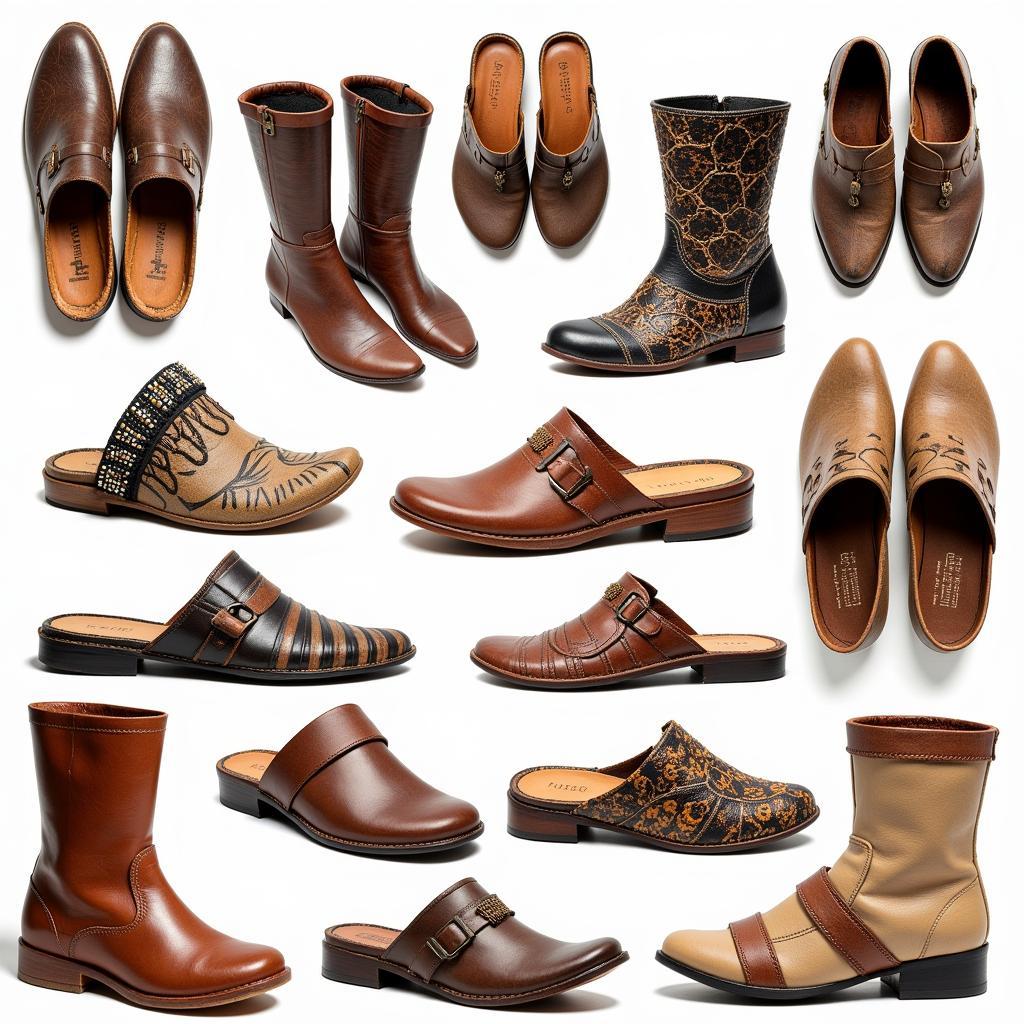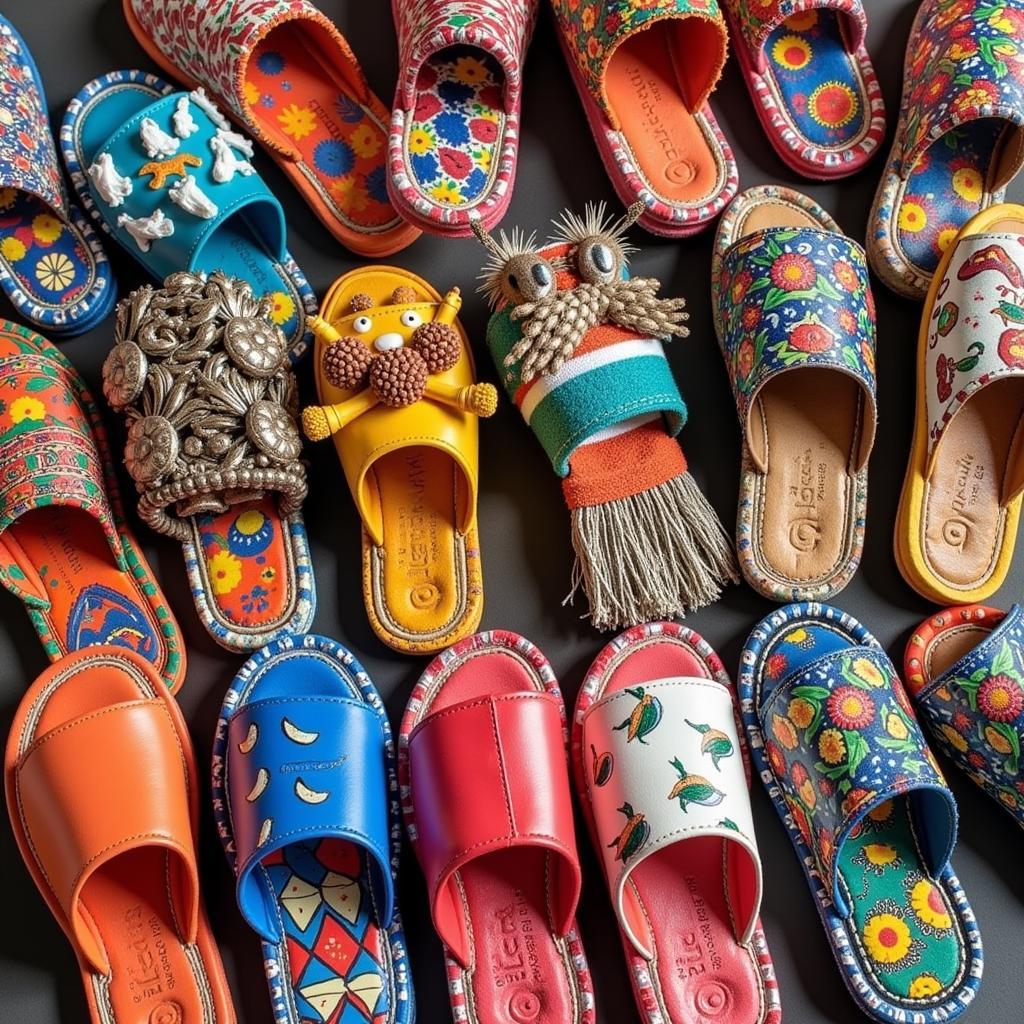Exploring African Culture Footwear
African Culture Footwear is more than just protection for the feet; it’s a vibrant expression of identity, history, and tradition. From the intricate beadwork of the Maasai to the colorful leather sandals of North Africa, each style tells a story, reflecting the diverse landscapes and rich heritage of the continent. Let’s delve into this fascinating world and uncover the unique stories behind these incredible creations.
Footwear in Africa plays a significant role, transcending its purely practical function. It signifies social status, ethnicity, and even spiritual beliefs. The materials used, the designs incorporated, and the occasions on which specific footwear is worn all contribute to a complex and captivating narrative. Exploring African culture footwear offers a glimpse into the heart of the continent’s diverse communities. Check out these African dad sandals for a modern take on traditional styles.
The Significance of Traditional African Footwear
Traditional African footwear often incorporates locally sourced materials, reflecting the close relationship between communities and their environment. From woven grass sandals perfect for navigating arid landscapes to intricately carved wooden clogs ideal for wetter climates, the footwear demonstrates an ingenious adaptation to the diverse environments found across Africa.
For many communities, footwear isn’t just about practicality; it’s a powerful symbol of status and identity. Elaborate beadwork, vibrant colors, and unique designs can indicate social standing, marital status, or even membership within a specific group. This symbolic significance adds another layer of depth to the study of African culture footwear. You might be interested in browsing an African clothing boutique near me to see these styles firsthand.
 Traditional African Footwear: A Variety of Styles and Materials
Traditional African Footwear: A Variety of Styles and Materials
Regional Variations in African Culture Footwear
Across the vast expanse of Africa, distinct regional styles have evolved, each reflecting the unique cultural nuances of its people. In North Africa, leather sandals, often adorned with intricate embroidery or metalwork, are common. These sandals, practical for the hot climate, are often passed down through generations, becoming cherished heirlooms.
East Africa boasts a rich tradition of beaded footwear, particularly among the Maasai people. These elaborate designs, created with vibrant beads, are not merely decorative; they tell stories, convey messages, and signify important life events. The artistry and symbolism embedded in Maasai beadwork are truly remarkable. For those interested in hunting apparel, there are resources available on African hunter and outfitters.
What are some common materials used in African footwear?
Common materials include leather, beads, wood, raffia, and recycled tires.
How does African footwear reflect cultural identity?
Footwear designs often incorporate symbols, colors, and materials specific to a particular tribe or region, showcasing their unique identity and heritage.
In West Africa, brightly colored slippers and sandals made from leather, cloth, or even recycled materials are popular. These often feature bold patterns and designs, reflecting the vibrant energy and artistic expression of the region. Consider checking out some African American shoe brands for contemporary designs inspired by traditional aesthetics.
 West African Colorful Slippers and Sandals: A Burst of Vibrancy and Pattern
West African Colorful Slippers and Sandals: A Burst of Vibrancy and Pattern
Dr. Anika Nkosi, a renowned anthropologist specializing in African cultural studies, notes, “African footwear is a tangible expression of cultural identity, connecting individuals to their heritage and reflecting the unique stories of their communities.”
Another expert, Professor Abimbola Oluwole, a historian specializing in African art and design, adds, “The intricate craftsmanship found in African footwear demonstrates the deep artistic traditions and skills passed down through generations, showcasing the continent’s rich cultural legacy.”
In conclusion, African culture footwear is a captivating subject, offering a window into the diverse traditions and artistic expressions of the continent. From the practical to the symbolic, each style tells a story, reflecting the rich tapestry of African culture. Exploring African culture footwear allows us to appreciate the intricate craftsmanship, the deep cultural significance, and the enduring legacy of these unique creations. Explore the elegance and versatility of the African kimono dress for a contemporary fashion statement.
FAQ
- What is the significance of beadwork in African footwear? Beadwork often symbolizes status, tells stories, and conveys messages within a community.
- What are some common materials used in traditional African footwear? Leather, beads, wood, raffia, and even recycled materials are frequently used.
- How does African footwear adapt to different climates? From sandals designed for hot climates to wooden clogs suitable for wetter regions, footwear adapts to the diverse environments across Africa.
- Where can I find examples of African footwear? Museums, cultural centers, and online marketplaces often showcase a variety of African footwear.
- How can I support African artisans creating footwear? Purchasing directly from artisans or fair trade organizations helps support their craft and livelihoods.
- Are there modern interpretations of traditional African footwear? Yes, many contemporary designers draw inspiration from traditional designs, creating modern and stylish interpretations.
- What is the cultural significance of wearing specific types of footwear in Africa? Specific footwear can signify social status, marital status, or membership within a particular group.
Common Scenarios and Questions:
- Scenario: A traveler wants to buy authentic African footwear. Question: Where can I find reputable sellers of handcrafted African footwear?
- Scenario: A student is researching African art and culture. Question: What are some good resources for learning more about the symbolism and history of African footwear?
- Scenario: A fashion designer is looking for inspiration. Question: How can I incorporate elements of traditional African footwear design into my own creations?
Further Exploration:
For more information on African fashion and culture, explore other articles on our website.
Need Help?
For any inquiries or assistance, please contact us:
Phone: +255768904061
Email: kaka.mag@gmail.com
Address: Mbarali DC Mawindi, Kangaga, Tanzania
We have a 24/7 customer service team ready to help.

